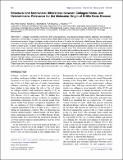Structural and Mechanical Differences between Collagen Homo- and Heterotrimers: Relevance for the Molecular Origin of Brittle Bone Disease
Author(s)
Chang, Shu-Wei; Shefelbine, Sandra J.; Buehler, Markus J
DownloadChang-2012-Structural and Mecha.pdf (898.9Kb)
PUBLISHER_POLICY
Publisher Policy
Article is made available in accordance with the publisher's policy and may be subject to US copyright law. Please refer to the publisher's site for terms of use.
Terms of use
Metadata
Show full item recordAbstract
Collagen constitutes one-third of the human proteome, providing mechanical stability, elasticity, and strength to organisms. Normal type I collagen is a heterotrimer triple-helical molecule consisting of two α-1 chains and one α-2 chain. The homotrimeric isoform of type I collagen, which consists of three α-1 chains, is only found in fetal tissues, fibrosis, and cancer in humans. A mouse model of the genetic brittle bone disease, osteogenesis imperfect, oim, is characterized by a replacement of the α-2 chain by an α-1 chain, resulting also in a homotrimer collagen molecule. Experimental studies of oim mice tendon and bone have shown reduced mechanical strength compared to normal mice. The relationship between the molecular content and the decrease in strength is, however, still unknown. Here, fully atomistic simulations of a section of mouse type I heterotrimer and homotrimer collagen molecules are developed to explore the effect of the substitution of the α-2 chain. We calculate the persistence length and carry out a detailed analysis of the structure to determine differences in structural and mechanical behavior between hetero- and homotrimers. The results show that homotrimer persistence length is half of that of the heterotrimer (96 Å vs. 215 Å), indicating it is more flexible and confirmed by direct mechanical testing. Our structural analyses reveal that in contrast to the heterotrimer, the homotrimer easily forms kinks and freely rotates with angles much larger than heterotrimer. These local kinks may explain the larger lateral distance between collagen molecules seen in the fibrils of oim mice tendon and could have implications for reducing the intermolecular cross-linking, which is known to reduce the mechanical strength.
Date issued
2012-02Department
MIT Materials Research Laboratory; Massachusetts Institute of Technology. Center for Computational Engineering; Massachusetts Institute of Technology. Department of Civil and Environmental Engineering; Massachusetts Institute of Technology. Laboratory for Atomistic and Molecular MechanicsJournal
Biophysical Journal
Publisher
Elsevier
Citation
Chang, Shu-Wei, Sandra J. Shefelbine, and Markus J. Buehler. “Structural and Mechanical Differences Between Collagen Homo- and Heterotrimers: Relevance for the Molecular Origin of Brittle Bone Disease.” Biophysical Journal 102, no. 3 (February 2012): 640–648. © 2012 Biophysical Society
Version: Final published version
ISSN
00063495
1542-0086